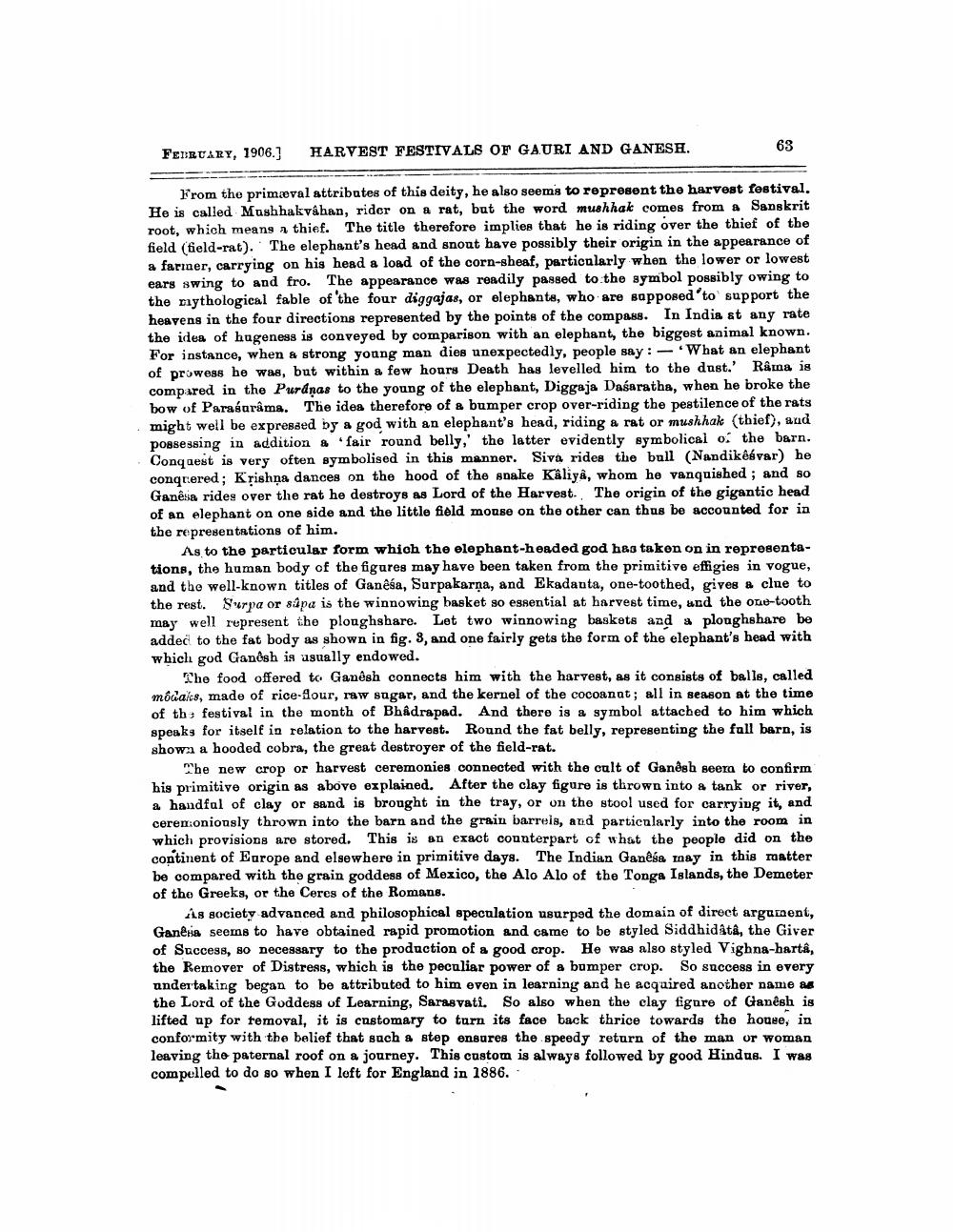________________
FENRUARY, 1906.)
HARVEST FESTIVALS OF GAURI AND GANESH.
63
From the primæval attributes of this deity, he also seems to represent the harvest festival. He is called Mushhakváhan, rider on a rat, but the word mushhak comes from a Sanskrit root, which means a thief. The title therefore implies that he is riding over the thief of the field (field-rat). The elephant's head and snoat have possibly their origin in the appearance of a fariaer, carrying on his head a load of the corn-sheaf, particolarly when the lower or lowest ears swing to and fro. The appearance was readily passed to the symbol possibly owing to the riythological fable of the four diggajas, or elephants, who are sapposed' to support the heavens in the four directions represented by the points of the compass. In India at any rate the idea of hugeness is conveyed by comparison with an elephant, the biggest animal known. For instance, when & strong young man dies unexpectedly, people say :- What an elephant of prowess he was, but within a few hours Death has levelled him to the dust.' Råma is compared in the Puranas to the young of the elephant, Diggaja Dasaratha, when he broke the bow of Parasarâma. The idea therefore of a bumper crop over-riding the pestilence of the rats might well be expressed by a god with an elephant's head, riding a rat or mushhak (thief), and possessing in addition a fair round belly,' the latter evidently symbolical of the barn. Conquest is very often symbolised in this manner. Siva rides the bull (Nandikêávar) he conqrered; Krishna dances on the hood of the snake Kaliya, whom he vanquished ; and so Ganessa rides over the rat he destroys as Lord of the Harvest. The origin of the gigantic head of an elephant on one side and the little field mouse on the other can thus be accounted for in the representations of him.
As to the particular form which the elephant-headed god has taken on in representations, the human body of the figures may have been taken from the primitive effigies in vogue, and the well-known titles of Ganesa, Surpakarna, and Ekadanta, one-toothed, gives & clue to the rest. Surpa or sipa is the winnowing basket so essential at harvest time, and the one-tooth may well represent the ploughshare. Let two winnowing baskets and a ploughshare be added to the fat body as shown in fig. 8, and one fairly gets the form of the elephant's head with which god Ganosh is usually endowed.
The food offered to Ganesh connects him with the harvest, as it consists of balls, called módalcs, made of rice-four, raw sugar, and the kernel of the cocoanat; all in season at the time of th festival in the month of Bhadrapad. And there is a symbol attached to him which speaks for itself in relation to the harvest. Round the fat belly, representing the fall barn, is showa a hooded cobra, the great destroyer of the field-rat.
The new crop or harvest ceremonies connected with the cult of Ganësh seera to confirm his primitive origin as above explained. After the clay figure is thrown into a tank or river, a handful of clay or sand is brought in the tray, or on the stool used for carrying it, and ceren:oniously thrown into the barn and the grain barrels, and particularly into the room in which provisions are stored. This is an exact counterpart of what the people did on the continent of Europe and elsewhere in primitive days. The Indian Ganesa may in this matter be compared with the grain goddess of Mexico, the Alo Alo of the Tonga Islands, the Demeter of the Greeks, or the Ceres of the Romans.
As society advanced and philosophical speculation usurped the domain of direct argument, Ganêra seems to have obtained rapid promotion and came to be styled Siddhidata, the Giver of Success, 80 necessary to the production of a good crop. He was also styled Vighna-hartâ, the Remover of Distress, which is the peculiar power of a bumper crop. So success in every undertaking began to be attributed to him even in learning and he acquired another name as the Lord of the Goddess of Learning, Sarasvati. So also when the clay figure of Ganesh is lifted up for temoval, it is customary to turn its face back thrice towards the house, in conformity with the belief that such a step ensures the speedy return of the man or woman leaving the paternal roof on a journey. This custom is always followed by good Hindus. I was compelled to do so when I left for England in 1886.




